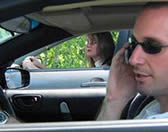Distracted Driving
 A teen driver applies make-up and talks while driving |
 Scene from an actual crash caused by distracted driving |
Report Shows States Increasing Efforts on Distracted Driving
Stronger Laws, Better Data and Greater Focus Among Findings
WASHINGTON, DC -- Today, the Governors Highway Safety Association (GHSA) released a new report that provides the first comprehensive look at state activities and programs to address the growing problem of distracted driving. The report, "Curbing Distracted Driving: 2013 Survey of State Safety Programs,"![]() details a host of approaches states are implementing. The survey found that states are aggressively pursuing solutions to distracted driving including: stronger laws, increased data collection, new education programs, public/private partnerships and a growing reliance on new media to spread the message.
details a host of approaches states are implementing. The survey found that states are aggressively pursuing solutions to distracted driving including: stronger laws, increased data collection, new education programs, public/private partnerships and a growing reliance on new media to spread the message.
State highway safety agencies from every state as well as the District of Columbia, Guam and American Samoa participated in the survey. Key findings are noted below.
- Distracted driving has emerged as a priority for state highway safety agencies. Thirty-nine states and D.C. indicated that distracted driving is included in their Strategic Highway Safety Plans (SHSPs). These plans reflect the statewide highway safety priorities of state safety-related agencies including Departments of Transportation, Departments of Motor Vehicles, as well as highway safety offices and many other state and local agencies. The detailed plans are only updated every few years; to already have more than half of the states listing distraction as a priority reflects the states' commitment on this serious issue. GHSA expects additional states to include distraction as SHSPs are updated.
- States have improved data collection efforts. In 2003, only 17 states collected information about distraction as a factor in crashes. Today, 43 states and D.C. report they collect this crucial data. Good data is a key component of a strong highway safety program, and GHSA is confident every state will include distraction in the near future.
- States are educating new drivers about distraction. In 2003, AAA reported that only five states had distinct distracted driving sections in their driver license manuals. Today, 45 states and D.C. have these sections. Additionally, distracted driving is a component of driver education in 18 states and D.C., and it is a question on the driver license test in 17 states and D.C.
- States have been passing a variety of distracted driving laws. As of February 2015, Fourty-four states, D.C., Puerto Rico, Guam, and the U.S. Virgin Islands now ban text messaging by all drivers. The first state to do this was Washington in 2007, so states have been moving very quickly in this area. Fourteen states, D.C., Puerto Rico, Guam, and the U.S. Virgin Islands ban hand-held cell phone use behind the wheel for all drivers. School bus drivers are prohibited from talking behind the wheel in 20 states and D.C.
- States are emphasizing public education. Fourty-seven states and D.C. have public information/education campaigns to warn about the dangers of driver distraction. Two states noted they have initiated efforts to provide training or technical assistance to the judiciary on this topic.
- Public/private partnerships are increasing. Thirty-five states are working with other state agencies and private employers to address distracted driving. Sixteen states and D.C. have worked with other state agencies or private companies to develop distracted driving policies for their employees.
- States are using new technology to educate motorists. Fifteen states and D.C. are using social networking sites like Twitter and Facebook to promote anti-distracted driving messages.
The Governors Highway Safety Association (GHSA)® is a nonprofit association representing the highway safety offices of states, territories, the District of Columbia and Puerto Rico. GHSA provides leadership and representation for the states and territories to improve traffic safety, influence national policy and enhance program management. Its members are appointed by their Governors to administer federal and state highway safety funds and implement state highway safety plans. Contact GHSA at 202-789-0942 or visit www.ghsa.org ![]() .
.
National & Statewide Organizations
- National Highway Traffic Safety Administration
(NHTSA)

- Distracteddriving.org

- Driver's
Educational School, Inc
 .
. - Centers for Disease Control and Prevention

Relevant Articles and Statistics
- C.H.O.P:
Teen Driving Risk Factors
 (94 KB)
(94 KB) - C.H.O.P:
10 Things People Don't Know About Teen Driving
 (92 KB)
(92 KB) - C.H.O.P:
Three Ways Parents Can Help Their Teens Be Safe
On The Road
 (94 KB)
(94 KB) - IIHS:
1st Evidence of Effects of Cell Phone Use on Injury
Crashes
 (33 KB)
(33 KB) - 2013 NHTSA
Traffic Safety Facts Overview

- NHTSA
Driver Cell Phone Use Facts
 (196 KB)
(196 KB) - Virginia
Tech. Cell Phone Study
 (388 KB)
(388 KB) - 2002-2004
Cell Phone Related Crash Rates on Alaska Roads
 (40 KB)
(40 KB) - 2002-2004
Cell Phone Related Crash Rates at Alaska Intersections
 (40 KB)
(40 KB) - 2002-2008 Crashes Involving Cell Phone Use
 (86 KB)
(86 KB)
Cell Phones
Several leading studies have shown that using a cell phone while driving increases your chance of getting into a crash by nearly 400%. When dialing a phone number or engaging in intense conversation, you're not watching the road like you should. A "hands-free" apparatus is helpful, but they can't prevent you from becoming involved in a conversation and losing concentration. Your best defense is to pull off the road and stop in a safe place before using your phone.
However, states are increasing their efforts to ban drivers from using cell phones altogether. Below are some links to those efforts:
- Cell
Phone Driving Laws In All 50 States

- Countries
That Ban Cell Phones While Driving

- Zoom Safer driving software

Avoid Being A Statistic
- Stay focused and pay attention on the road!
- Avoid driving when you're tired
- Avoid taking any drugs, legal or otherwise, while driving
- Try not to drive when you're angry or upset
- Limit your interaction with passengers and other drivers
- Keep both hands on or close to the steering wheel
- Keep your eyes on the road!
Safety Topics
- DEC / DRE
- Distracted Driving
- Fatality Analysis Reporting System (FARS)
- Headlights
- Media Campaigns
- Occupant Protection
- DUI Information & Impaired Driving
- Senior Driving in Alaska
- Teen Driving in Alaska
- Traffic Records

